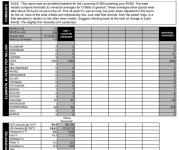N
It may not be cavitation in the classical sense, where the fluid is vaporizing. It may simply be a vacuum that is created and then collapses.
This is the very definition of cavitation. Oil does contain some air. Physical bubbles when running and dissolved after some operation time. Example: Rod bearing supply hole location relative to the pressure region near TDC and BDC - is important to cavitation erosion of bearings.
Hydraulic pumps in small regions of the interior can occur at all temps.
There is not a specific viscosity at which it will occur, so highly likely it is cavitation. The intensity and certainly time will determine the damage or rate of damage occurring. In the Lyc oil system, it could even be ( and is likely) tiny leaks in the suction side. Many pumps have machined covers and no o-rings.
But - -I think cavitation erosion is a distant spur off the trunk of this preheat discussion.
DanH says - is there damage - -well . . . damage -wear - there are several specific conditions that meet that criteria for cold starts. Nothing is perfect in an engine. Stuff happens or they would last forever- it is how often does a damaging event occur, does it advance, and how much does it accumulate before it affects the TBO, is it small enough to be self healing or non-progressive? The aircraft engine is more of a case study in damage collection than most engine applications.
Lets talk sliding surfaces like bearings, gears, bushings - - In detail there is no smooth surface, it has a surface finish, in the micro world there are asperities - tips of the high spots that make up this surface finish. The thinner the oil film, the more the asperities make physical contact. This happens on engine start up. ore if the oil was left hot to drip off the parts. This is the zone of "boundary lubrication" where additives provide the benefit of reducing metal transfer in the process. Then - how long the condition persists, hardness of the materials, the surface finishes, is it a continuous process or intermittent, and whether micro zones of heat occur will determine if the damage is wear, scuffing, or worse. Does it self heal when the condition changes? Many questions -the world of the engine designers and developers.
It is not a black and white situation, it is degree of occurrence, collection of events and statistical probability of a catastrophic failure within the desired life.
Surely you haven't read this far, I'll delete it tomorrow. This could become one of never ending debates.
Colder is worse, warmer is better for wear. More colder starts ( assuming the battery and starter hold up) the more accumulation of damage. If this occurs more than the expected use within the TBO, then it develop in to a measurable deficiency in operation - low oil pressure at idle, or an actual bearing failure. Unless the plane is used every 4 days in Canada or Alaska and started below the recommendations, it will still reach TBO. Fewer parts may be reusable, but it will get there. Pete and Vlad (two known VAFers) are leading the way on running past TBO maybe they will say how their engines are operated.





